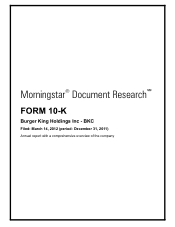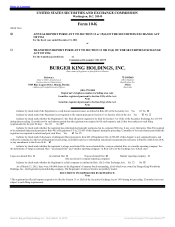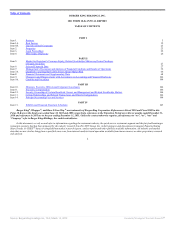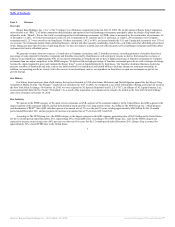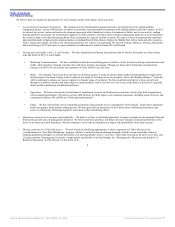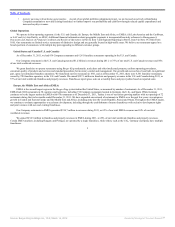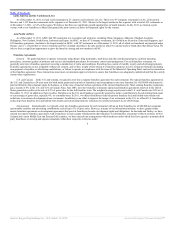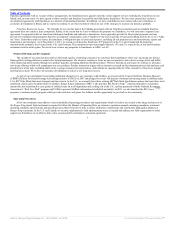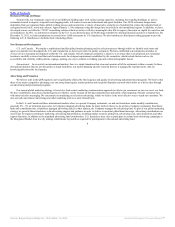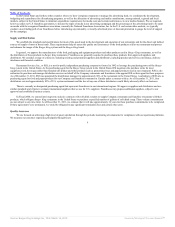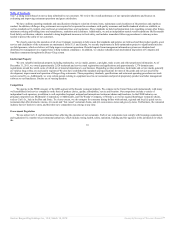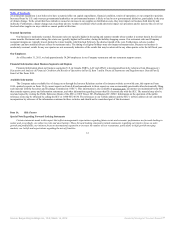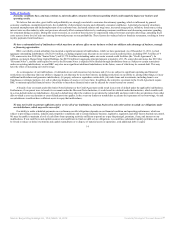Burger King 2011 Annual Report Download - page 8
Download and view the complete annual report
Please find page 8 of the 2011 Burger King annual report below. You can navigate through the pages in the report by either clicking on the pages listed below, or by using the keyword search tool below to find specific information within the annual report.
Table of Contents
franchise agreements with us. As part of these arrangements, the franchisees have agreed to provide certain support services to third party franchisees on our
behalf, and, in some cases, we have agreed to share royalties and franchise fees paid by such third party franchisees. We have also entered into exclusive
development agreements with franchisees in a number of international markets. In addition, we have established a joint venture with a new franchisee to
accelerate development in Brazil, and we expect to continue to use this investment vehicle as one of the strategies to increase our presence globally.
Franchise Restaurant Leases. We typically do not own the land or the building associated with our franchise restaurants and our standard franchise
agreement does not contain a lease component. Rather, to the extent that we lease or sublease the property to a franchisee, we will enter into a separate lease
agreement. For properties that we lease from third-party landlords and sublease to franchisees, leases generally provide for fixed rental payments and may
provide for contingent rental payments based on a restaurant’s annual gross sales. Franchisees who lease land only or land and building from us do so on a “triple
net” basis. Under these triple net leases, the franchisee is obligated to pay all costs and expenses, including all real property taxes and assessments, repairs and
maintenance and insurance. As of December 31, 2011, we leased or subleased to franchisees 997 properties in the U.S. and Canada and 84 properties
internationally, primarily sites located in the U.K. and Germany. These properties represented approximately 15% and 2%, respectively, of our total franchise
restaurant count in such regions. We do not own or lease any properties to franchisees in APAC or LAC.
Product Offerings and Development
The strength of our menu has been built on the brand equities of allowing consumers to customize their hamburgers “their way” and using our distinct
flame-grilled cooking platform to make better tasting hamburgers. We intend to continue to focus on our core products, and to drive average check and traffic,
while improving menu options through new product launches, including additional healthy products. We have introduced, and expect to continue to introduce,
new menu offerings which will complement our core products. Product innovation begins with an intensive research and development process that analyzes each
potential new menu item, including market tests to gauge consumer taste preferences, and includes an ongoing analysis of the economics of food cost, margin
and final price point. We believe new product development is critical to our long-term success.
As part of our commitment to providing nutritional alternatives to our customers with children, we are part of the Council for Better Business Bureau’s
(CBBB) Children Food and Beverage Advertising Initiative (CFBAI) in 2007 and pledged to restrict 100 percent of national advertising aimed at children under
12 to BK® Kids Meals that meet stringent nutrition criteria. In the U.S., we currently have three existing BK®Kids Meal lunch/dinner options that meet these strict
nutritional criteria and a breakfast meal for children. Burger King Corporation (“BKC”) also provides BK Positive Steps™ nutrition materials in restaurants
nationwide, has transitioned to zero grams of artificial trans fat in all ingredients and cooking oils in the U.S., and has partnered with the National Restaurant
Association’s “Kids Live Well” program and USDA to promote MyPlate information to both kids and adults. In 2011, we also launched the BK Crown TM/MC
program, a consumer loyalty program which provides activities and games for children and the opportunity to give back to the community.
Operating Procedures
All of our restaurants must adhere to strict standardized operating procedures and requirements which we believe are critical to the image and success of
the Burger King brand. Each restaurant is required to follow the Manual of Operating Data, an extensive operations manual containing mandatory restaurant
operating standards, specifications and procedures prescribed from time to time to assure uniformity of operations and consistently high quality products at
Burger King restaurants. In the U.S. and Canada, we recently implemented a field optimization project to expand and enhance our field organization to better
support our franchisees in an effort to drive sales, increase profits and improve restaurant operations.
7
Source: Burger King Holdings Inc, 10-K, March 14, 2012 Powered by Morningstar® Document Research℠

